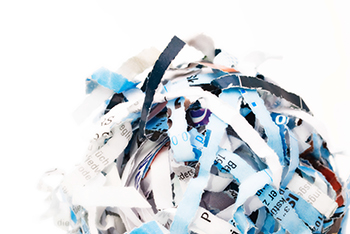 By now, most attorneys have heard (repeatedly) about the many advantages of reducing paper file storage (and usage) by “going paperless” (cost savings, time savings, added convenience, and so on). And if you are one of the increasing number of law practices that have already made, or are currently considering, adopting a paperless policy, it is important to know that to make the process work, you need office-wide buy-in to the new workflow. (For a comprehensive “how-to” article, see “Going Paperless,” by Nerino Petro in the March 2014 Wisconsin Lawyer.)
By now, most attorneys have heard (repeatedly) about the many advantages of reducing paper file storage (and usage) by “going paperless” (cost savings, time savings, added convenience, and so on). And if you are one of the increasing number of law practices that have already made, or are currently considering, adopting a paperless policy, it is important to know that to make the process work, you need office-wide buy-in to the new workflow. (For a comprehensive “how-to” article, see “Going Paperless,” by Nerino Petro in the March 2014 Wisconsin Lawyer.)
Encourage Scanning and Shredding, Discourage Printing
Model Specifications and Recommendations for Scanners and Shredders
Scanner Specifications
- duty cycle (scans per day)
- scanning speed (pages per minute)
- paper-chute capacity (pages in sheet feeder)
- easy to use
Recommended: Fujitsu ScanSnap iX500 ($430 on Amazon.com); Canon imageFORMULA DR-C225 ($375 on Amazon.com).
Shredder Specifications
- run time/cycle duty (time before needing cool down)
- number of sheets it can shred at a time
- bin capacity (how long before emptying)
- cut pattern (cross cut or micro cut)
Recommended: Fellowes Powershred 79Ci ($175 on Amazon.com); AmazonBasics 12-Sheet Cross-Cut Shredder ($50 on Amazon.com); Ativa 10M Micro-Cut Shredder ($179 at Office Max/Office Depot. Check your State Bar member benefits for OfficeMax Partner AdvantageSM Program discounts.); AmazonBasics 12-Sheet High-Security Micro-Cut Shredder ($100 on Amazon.com).
Gaining buy-in to the new workflow can take time, but to help you or your employees along, you should encourage scanning and shredding, and discourage printing, by making the former easier and the latter more difficult. One of the best ways to do this is to keep a smaller scanner and shredder in or near each of your employees’ individual workspaces – as opposed to placing large industrial models in a central location. Conversely, you may want to remove printers from individual workspaces to less convenient areas.
So, if it is advisable to provide smaller scanners and shredders, which models should you use?
Scanner Models
You may find that your office does require a large digital copy center that not only includes a flatbed scanner but also can handle large volumes of scanning (perhaps your practice areas deal with large product designs or real estate diagrams or involve high volumes of medical records). Whether or not this is true for your practice, you will want to supply desktop sheet-fed scanners for individual workspaces. When comparing such scanners, the important specifications to consider are each model’s duty cycle (the maximum number of scans per day that a given scanner can reasonably process), scanning speed (how many pages per minute it can scan), and paper-chute capacity (how many sheets it can hold in its sheet feeder). It is also important that the device be easy to use.
That may be more than you wish to consider, so let me save you the trouble of hunting for the right scanner, and recommend the Fujitsu ScanSnap iX500 ($430 on Amazon.com). It can handle 750 pages per day, at a speed of 25 pages per minute, and has a 50-sheet capacity paper chute. It is also very simple to set up and use.
The Fujitsu can easily be found on Amazon, but it is sometimes difficult to find in brick and mortar stores. If you need a scanner right away, the Canon imageFORMULA DR-C225 ($375 on Amazon.com) is a competent alternative that, unlike the Fujitsu, is also TWAIN compliant (if you don’t know what that is, you probably don’t need it).
So You Want To …
As attorneys, when there is a task we want to perform more efficiently, or an office product that we believe could improve our work lives in some way, visiting stores and scouring the Web to determine the best solution doesn’t always make it to the top of our to-do lists. Rather than go without, let Practice411™ do the work for you.
You might also be interested in the following columns: So, You Want To …
Shredder Models
For your initial transition to a paperless office, or if you need to shred a very high volume of documents, you should consider at least one heavy-duty paper shredder or a shredding service. To encourage consistent shredding as part of your office’s daily workflow, however, it is a good idea to have several smaller shredders in more convenient locations. When comparing models, you will want to consider a shredder’s run time/cycle duty (how long it can run before overheating and needing to shut off), the number of sheets of paper it can shred at a time, its bin capacity (how long can you go in between emptying), and cut pattern (cross cut will be secure enough for most, but micro cut is available if you deal with particularly high-security items).
Again, there is much to consider, so let me recommend a few models. First up is the Fellowes Powershred 79Ci ($175 on Amazon.com). The 79Ci is a cross-cut shredder with a 9” opening, 14-sheet capacity, and six-gallon bin capacity. Its cycle duty is 12 minutes on/20 minutes off, and it boasts an excellent five-year warranty on its blades. With its proven record and good warranty, the Fellowes would be my choice for most lawyers’ workspaces.
 Tison Rhine is the advisor to the State Bar of Wisconsin Law Office Management Assistance Program (Practice411™). Reach him at (800) 444-9404, ext. 6012, or by email.
Tison Rhine is the advisor to the State Bar of Wisconsin Law Office Management Assistance Program (Practice411™). Reach him at (800) 444-9404, ext. 6012, or by email.
But for individual offices that require only rare shredding, an economical alternative is the AmazonBasics 12-Sheet Cross-Cut Shredder ($50 on Amazon.com). This AmazonBasics shredder has an 8.7” opening, a smaller 4.8-gallon bin, and can only run continuously for five minutes before needing a 30-minute cool-down, but it should be adequate for occasional small jobs and has a price that can’t be beat.
Finally, if you require greater security, try the Ativa 10M Micro-Cut Shredder ($179 at Office Max/Office Depot), which offers 20 minutes of continuous shred time and a six-gallon bin, or the AmazonBasics 12-Sheet High-Security Micro-Cut Shredder ($100 on Amazon.com), which offers eight continuous minutes and a 6.7-gallon bin.You will find that purchasing several smaller scanners and shredders will not cost much more (if any) than purchasing single, commercial-grade machines. And in the end, the added convenience will help lead to dependable adherence to your office’s paperless policy.
